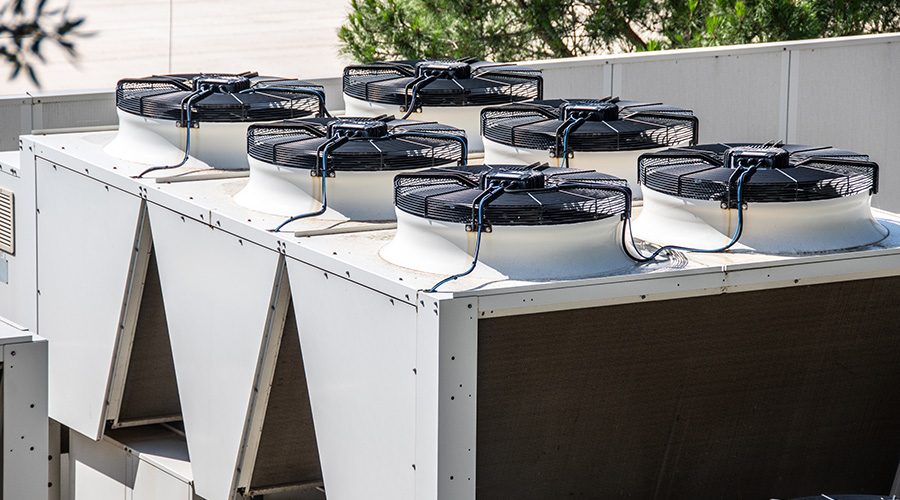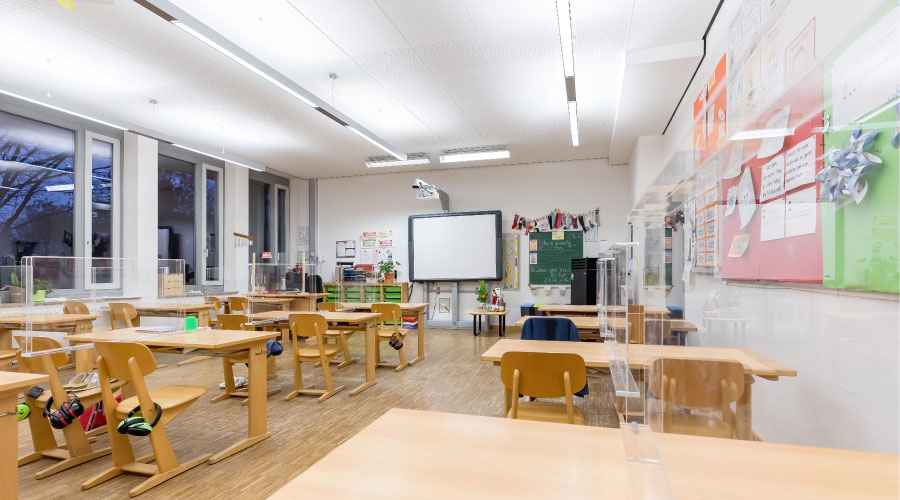CBR Threats May Demand Higher Levels of Security
Choices about HVAC design, security procedures and hardware, and architecture can help minimize the harm if an attack were to occur
Although no building or component can provide fail-safe protection, buildings can play an important role in the defense against terrorist attacks, even when the weapons used are chemical, biological or radiological (CBR). One element of the building that is receiving more security scrutiny than it did in the past is the HVAC system. The ventilation system and air filtration — along with building architecture and security hardware and procedures — can help reduce the likelihood of loss of life and mass contamination of the facility.
Before any steps are taken, a risk assessment should be conducted identify threats to and vulnerabilities. If the analysis shows a need for action to protect the building and its occupants against a CBR attack, the facility executive should not overlook the importance of the HVAC system.
One important step is to program controls to allow ventilation systems to be placed in the appropriate mode from a single switch. Multiple devices may well have to be de-energized in an emergency, often at different locations. It is not reasonable to think an operator can control all these devices individually under emergency conditions.
Ventilation strategies will depend on whether the CBR release occurs inside or outside the building. If there are no visible signs of an outdoor release, and if some areas of the building appear to be more severely affected than others, then the assumption should be made that the release was indoors. A biological or radiological agent will almost never cause immediate symptoms, while a chemical agent almost always will.
If the release is outside, supply fans must be shut off unless the HVAC system is equipped with an appropriate filtration system; if the system does have a high-performance filtration system as described below, supply fans should be kept running. Exhaust fans should be shut off, fresh air intakes and building envelope openings closed, elevators recalled to the lobby, and all doors locked, including those to the loading dock and garage. Occupants should remain indoors, preferably in the interior of the building.
It’s a different story if a release occurs inside the building. Closing duct dampers, where possible, will help isolate the zone of release. The stairwell pressurization system should be activated using 100 percent outside air as occupants are evacuated to a predetermined location.
Type of Release
Different measures are called for depending on whether the release involves biological, radiological or chemical agents. For a chemical release, the goal is to reduce the concentration to which people are exposed. The best strategy is to provide 100 percent outdoor air to areas surrounding the floor or area of release while providing 100 percent exhaust only to the floor or area of release. If that is not possible, the next best approach is to provide the entire area with 100 percent outdoor air and 100 percent exhaust. If that is not possible, all supply and return fans should be shut down until the type of hazard and extent of spread is determined. Once this information is known, consideration should be given to reactivating the HVAC system. In most buildings the normal operation of the system will provide some outdoor air and will exhaust some indoor air, providing a beneficial diluting effect.
For a biological or radiological release, the goal is to minimize the number of people exposed. That means shutting down all supply, return and exhaust fans. Fans should not be restarted, under any circumstances, unless directed by a competent authority.
In the case of a biological release, segregate people known to be exposed to avoid cross-contamination.
For ordinary operation, non-public areas should have a slightly positive pressure with respect to public areas and the outdoors. This will minimize air infiltration from any external release. In ductwork distribution zoning, consider separating zoning (and air flow paths between zones) to reduce the number of people exposed to an internal release. Large central systems can quickly spread contaminants; more decentralized systems would be preferred in high-risk facilities.
The ventilation system should be designed to isolate entry and storage zones, such as the lobby, mailroom and receiving areas. These are locations where there is the greatest risk of entry and where screening can be done in high-risk buildings. Full-height walls are advisable, as is sealing all openings as would be required for a smoke barrier. Separate air handlers will isolate these areas from the rest of the building. The supply and return ducts entering each public lobby, other unsecured public areas, and mailrooms should have quick-closing isolation dampers, which could be manually activated by a 24/7 manned guard booth located at each entry. Dedicated exhaust systems should serve each public area. These areas should be maintained at a slight negative pressure to the remainder of the building. In high-traffic areas, airlocks or vestibules are worth considering.
Air Filtration
Air filtration can provide an additional line of defense against a CBR release. The filter bank can be installed in series with the main air handling unit for continuous filtration or in a bypass configuration for switched-in CBR filtration. After the risk assessment establishes the required protection and associated range of efficiencies, a comparison of the many styles and configurations should be based upon a complete life cycle cost analysis. Will improved IAQ justify the upgrade and operating costs? Can the maintenance be sustained in terms of personnel training and material cost? How will hazardous waste be disposed of? It will become obvious from the analysis that energy overwhelms all other cost factors, including first cost.
Analyzing Choices
There are several major types of filters with performances suitable for CBR filtration. The first are HEPA filters. These filters are 99.97 percent efficient in capturing 0.3 micron diameter particles; improvements in media manufacturing have resulted in even higher efficiencies.
Most known bacteria range in size from 0.2 to 5 microns in diameter. Viruses are between 0.01 and 0.3 microns. However, viruses need a host to live and therefore usually are attached to a bacteria or other large object such as a water droplet (0.5 to 5 microns).
The addition of building-wide HEPA filters carry an extremely high construction, maintenance, and operating cost, particularly in a retrofit situation. Even in cases where the costs cannot be justified for the entire building, however, it may be worth installing HEPA filters in the ductwork of the stairway emergency ventilation system if the intake is at low level. The higher grade of filtration can be justified because of the critical nature of stairs and the concentration of people in a confined area when it is used as the emergency egress. Anthrax spores are difficult to clean on a large scale, such as a stairway. A week or multi-week shutdown of stairways would virtually take the entire building off-line.
High-efficiency filters — those with minimum efficiency reporting value (MERV) ratings of 14, 15 or 16 on a scale of 1 to 20 — can also be considered for defense against biological attacks. The higher the MERV number designation, the better the capture efficiency, particularly at the smaller sizes. Their filtration efficiency, ranging from 90 percent to 99 percent for anthrax bacteria (1 micron) and nearly 100 percent in the spore state (2 microns) is fairly similar to a HEPA filter (99.97 percent at 1 micron). However, for smaller pathogenic bacteria and water-droplet-carrying viruses that are between 0.2 and 0.5 microns, their efficiency drops to the range of 60 percent to 95 percent. These filters would not guard against chemical gas attack.
High-efficiency filters represent a cost-effective alternative to HEPA filters when very high filtration of particles smaller than 1 micron is not required. They cost less, impose less air pressure demand on the fan motor and tend to require less retrofit work to an existing air handling system.
A third category of filtration that can be considered for defense against the toxic gases that terrorists might use is activated carbon. Activated carbon adsorbs, not absorbs, airborne odors and vapors. When a material adsorbs something, it means that it attaches to it by chemical attraction.
Activated carbon adsorbs to its own surface. When there are no more surfaces left, activated carbon is depleted of its effectiveness. Large amounts of carbon will last longer than small amounts. The thicker the carbon filters, the better its adsorption. Granular-activated carbon is more effective than a 1- or 2-inch thick impregnated carbon pad. The performance of activated carbon is affected by temperature and humidity, contaminant chemistry and concentration.
Activated carbon can be impregnated with chemicals to make it a more effective adsorbent. The broad-based chemical ASZM-TEDA (copper, silver, zinc and molybdenum-triethylenediamine) is currently considered by the Defense Department and the Homeland Security Department to be the most effective collective filtration for industrialized and militarized chemicals, when used in conjunction with an adequate residence time across the carbon bed (i.e., the amount of time the activated carbon is in contact with a pollutant).
Like HEPA filters, activated carbon filters have very high construction, maintenance and operating costs, especially in existing buildings. What’s more, careful coordination between the architectural room plan and structural floor supports is required for carbon filters and housing because of their weight.
Other Filtration Technologies
Although low- and medium-efficiency filters with an antimicrobial agent are available, there is not sufficient consensus in the industry to recommend these filters for anywhere but residential applications. Direct contact is required for an antimicrobial agent to destroy microorganisms, and dust build-up will tend to inhibit direct contact. There is no evidence that microorganisms that lodge downstream within the filter media are inhibited or killed.
One type of ultraviolet light, UV-C, has been used as a germicide in health care, food processing and waste treatment for more than 50 years. However, because numerous variables affect the killing ability of UV-C emitters — including air temperature, humidity and tube cleanliness — it is recommended that for purposes of bioterrorist defense, the UV-C emitter only be considered as a supplement to air filters.
At least one manufacturer offers a hybrid filtration system that consists of a low wattage electrostatic air cleaner with a UV-C emitter installed upstream. The filtration efficiency is about 95 percent for 1-micron particles; however, efficiency drops to 75 percent for 0.5-micron particles and to 33 percent for 0.3-micron particles.
Most of the options considered for building infrastructure enhancement apply to both new and existing structures. With existing buildings, however, the economic realities of renovations may limit choices.
Terry Gillick is vice president, security technology, Syska Hennessy Group, New York City. The firm provides consulting, engineering, technology and construction services in such areas as building system design, facilities management, energy management, security technology consulting/engineering and turnkey design/build.
Risks May Justify Changes in Safety and Security Procedures and Hardware
The attacks of Sept. 11 have required facility executives to re-evaluate all aspects of security. A good example is emergency-response plans. It is now widely recognized that full-scale emergency-response training exercises should be held periodically to ensure that building occupants, tenants, maintenance personnel and first responders understand and remember their responsibilities.
Many facility executives have also expanded security measures beyond actions to prevent theft and protect personal safety. Some of these measures are easily and inexpensively carried out. One good step is to ensure that all levels of facility staff are notified of changes in threat conditions and protective measures. Similarly, these personnel should be encouraged to be alert and immediately report any threat or suspicious activity.
Although it is a more complicated and potentially more expensive matter than the measures just described, controlling the entry of people into the building is crucial when it comes to preventing a CBR attack. That means, for example, having a method of identifying all building occupants along with an updated list of personnel with unlimited or restricted access to the building. For areas requiring higher security, advanced access control technologies, such as finger print, retina scan and voice identification, may be appropriate.
Visitors and delivery persons must also be considered. Deliveries should be scheduled and verified against the schedule; unscheduled deliveries should be held outside the building, pending verification of the shipper and cargo by the recipient. If possible, all packages should be X-rayed before they enter the building, and all handbags and briefcases should be inspected. Loading docks should be supervised to avoid unverified or unauthorized deliveries. Underground parking garages should be secured.
It isn't just entry points into the building that may need to be secured. The security staff should inspect all storage areas and maintain logs. Access to electrical equipment rooms, main plumbing/fire protection rooms, potable water storage tanks, food storage, and air handling equipment rooms should be controlled; door alarms and security cameras may be advisable for high-risk facilities. Roof access should be secured.
|
| |
Building Architecture can help Prevent, Limit Attacks
In conjunction with HVAC and security system measures, the building itself plays an important role in preventing or ameliorating the effects of a CBR attack.
For example, for external releases, the building envelope plays a part in protecting the interior environment from contaminated outdoor air. Testing the air tightness of the envelope will ensure that the new or renovated building envelope will provide a good barrier.
Air intakes should be located either four stories above grade or preferably at the top of the building. If a grade level is unavoidable, perimeter security is important. This may consist of full-size solid walls at each intake, a sloped bird-screen top, and wide-angle camera and illumination. Relocation of air intakes to a secure façade of the building should also be considered.
Entryways also require attention. Lobbies and entrances should have full-height walls to isolate these high-risk areas. Vestibules or revolving doors in high-use areas will minimize infiltration and maintain pressure differentials.
It is important to address all routes by which a CBR release could enter a building. For example, exterior windows should be resistant to breaking by thrown objects, and operable windows should be locked. Like lobbies, mail rooms and receiving areas should be isolated with full-height walls.
|
Securing the Perimeter
The perimeter of the property can be made the first line of defense by introducing thorough inspection of vehicles at each entry point. Security personnel should be trained on proper inspection techniques.
Parking areas for visitors should be located at a safe distance from the building to provide blast protection.
The perimeter of the property and all building access points should be monitored.
Public water supplies can become contaminated or disrupted. For high-risk critical facilities, access to local water from wells or on-site potable tanks should be considered. Water supply to the building should be inspected periodically for vulnerability and possible tampering.
|
| |
Preparing for Disruptions in Power Supply, Telecommunication Services
While the electrical system itself will not spread contaminants, it can be a target. Facility executives should consider obtaining power from multiple sources and expanding generator capacity to pick up systems needed for CBR response functions. Main switchgear rooms, transformer vaults, distribution rooms and generator rooms must be secured against unauthorized entry. Sufficient emergency lighting is essential.
Telecommunication systems can be lost if either the distribution system or main facility is disrupted. Cell phones are also unreliable as relay stations may be targeted. A back-up plan for emergency communication to an outside point with hand-held two-way communication devices should be developed. Amateur radio operations can be helpful in providing communication during these periods, and relationships should be established in advance of need.
|
Related Topics:











